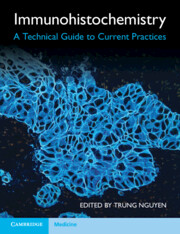Book contents
- Immunohistochemistry
- Immunohistochemistry
- Copyright page
- Dedication
- Contents
- Contributors
- Preface
- Chapter 1 Immunohistochemistry Fundamentals
- Chapter 2 Immunohistochemistry Quality Assurance and Quality Control
- Chapter 3 Automation and Robotics with the Leica Bond III
- Chapter 4 Automation and Robotics with the Roche Ventana BenchMark ULTRA
- Chapter 5 Automation and Robotics with the Agilent Dako Omnis
- Chapter 6 Immunohistochemistry for Research Applications
- Chapter 7 Troubleshooting Immunohistochemistry
- Chapter 8 Current Status of Immunohistochemistry
- Chapter 9 Immunohistochemistry for Future Applications
- Index
- References
Chapter 5 - Automation and Robotics with the Agilent Dako Omnis
Published online by Cambridge University Press: 16 June 2022
- Immunohistochemistry
- Immunohistochemistry
- Copyright page
- Dedication
- Contents
- Contributors
- Preface
- Chapter 1 Immunohistochemistry Fundamentals
- Chapter 2 Immunohistochemistry Quality Assurance and Quality Control
- Chapter 3 Automation and Robotics with the Leica Bond III
- Chapter 4 Automation and Robotics with the Roche Ventana BenchMark ULTRA
- Chapter 5 Automation and Robotics with the Agilent Dako Omnis
- Chapter 6 Immunohistochemistry for Research Applications
- Chapter 7 Troubleshooting Immunohistochemistry
- Chapter 8 Current Status of Immunohistochemistry
- Chapter 9 Immunohistochemistry for Future Applications
- Index
- References
Summary
Immunohistochemistry robotics and automation as defined by Agilent comes in the form of the Dako Omnis. An appraisal is given by a medical scientist with intimate knowledge of the principles behind the technology, the various machine components and Dako’s proprietary reagents. Daily operations with the instrument allow for an honest review of stain protocols, workflow logistics and maintenance obligations. An explanation of the unique dynamic gap technology is provided along with in-built quality assurance measures. As the Omnis is a new instrument when compared to Leica’s Bond III and Ventana’s BenchMark ULTRA, discussions are based upon the good and bad points of both the hardware and the software aspects. The reader should get an idea of how the Omnis produces stained slides and the capabilities of the machine.
Keywords
Information
- Type
- Chapter
- Information
- ImmunohistochemistryA Technical Guide to Current Practices, pp. 120 - 159Publisher: Cambridge University PressPrint publication year: 2022
References
Accessibility standard: Unknown
Why this information is here
This section outlines the accessibility features of this content - including support for screen readers, full keyboard navigation and high-contrast display options. This may not be relevant for you.Accessibility Information
- 1
- Cited by
